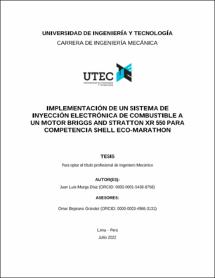Implementación de un sistema de inyección electrónica de combustible a un motor Briggs and Stratton XR 550 para competencia Shell Eco-Marathon
Resumen
El presente trabajo tiene por objetivo adaptar un Sistema de Inyección Electrónica el cual es posible programar en un motor a Carburador el cual tiene la finalidad de determinar la mejor configuración para reducir el consumo combustible, homogenizar la mezcla airé gasolina y reducir el impacto ambiental provocado por un control de inyección mecánico.
Con la inyección electrónica, es posible acoplar de una forma óptima la combinación aire–combustible y mediante ello obtener los indicadores de estequiometria, siendo el resultado la relación 14.7 de aire a 1 de combustible [1]. Mediante el cumplimiento de esta situación habrá sido posible lograr el índice Lambda con un valor de 1; en consecuencia, será posible obtener una mezcla homogénea; lo que significa que la mezcla no tendrá un exceso de combustible (mezcla rica) ni exceso de aire (mezcla pobre). Logrando esta condición cuando se realiza la combustión, será posible asegurar la disminución de los gases contaminantes del escape e incrementar la eficacia en la utilización de combustible.
A fin de concretar este proyecto, necesitamos contar con una Unidad de Control Electrónico Programable (ECU), para ello se requieren sensores, los cuales se encargarán de transmitir datos hacia la Unidad de Control del Motor. Por último, es necesario contar con actuadores quienes se encargarán de admitir las indicaciones de la Unidad de Control.
En definitiva, es necesario obtener un sistema con el menor costo posible en lo relacionado al consumo de combustible, y a su vez obtener una significativa reducción de la cantidad de emisiones contaminantes al ambiente, y todo ello en base a las pruebas y resultados obtenidos en la presente investigación. This investigation has the main objective to adapt an Electronic Injection System, which can be programmed into a Carburetor engine, which has the purpose of determining the best configuration to reduce fuel consumption, homogenize the air-gasoline mixture and reduce the environmental impact caused by a mechanical injection control. With electronic injection, it is possible to optimally adjust the air-fuel combination and thereby obtain the stoichiometry indicators, resulting in a 14.7 air to 1 fuel ratio [1]. By fulfilling this it will be possible to achieve the Lambda index with a value of 1; consequently, the engine will also be able to obtain a homogeneous mixture; which means that there will not be either fuel (rich mixture) or air (lean mixture) excess. By achieving this condition when combustion is carried out, it is safe to say there will be a reduction of polluting gases from the exhaust, and an increase in the efficiency of the fuel’s usage. In order to carry out this investigation, we need to have a programmable Electronic Control Unit (ECU). This requires certain sensors, which will be responsible of transmitting data to the Engine Control Unit. In addition, it is also necessary to have actuators who will be in charge of registering the indications of the Control Unit. In conclusion, it is necessary to obtain a system with lower amounts of polluting emissions to the environment, while aiming for the lowest possible cost in terms of fuel consumption ratio. Which ends up giving us a greater power and torque on the crankshaft output shaft.
Citación
Murga Díaz, J. L. (2022). Implementación de un sistema de inyección electrónica de combustible a un motor Briggs and Stratton XR 550 para competencia Shell Eco-Marathon [Tesis de Título Profesional, Universidad de Ingeniería y Tecnología]. Repositorio Institucional UTEC. https://hdl.handle.net/20.500.12815/310Colecciones
- Ingeniería Mecánica [73]


